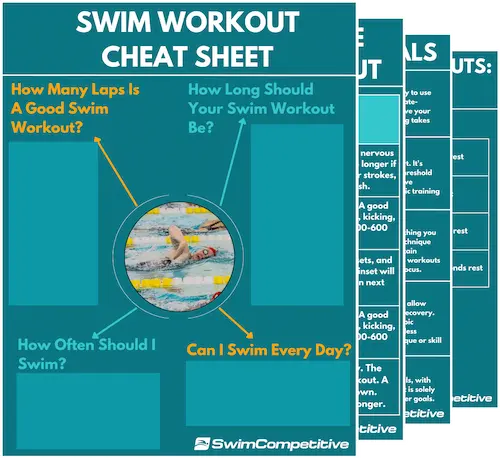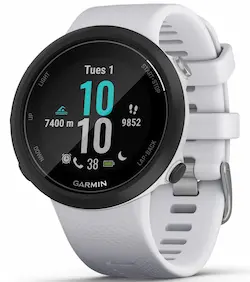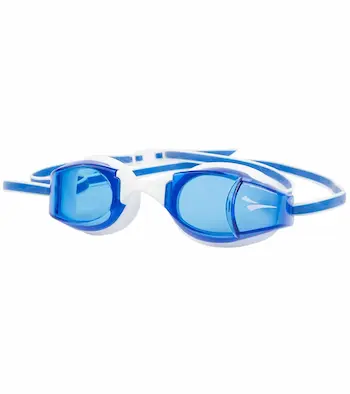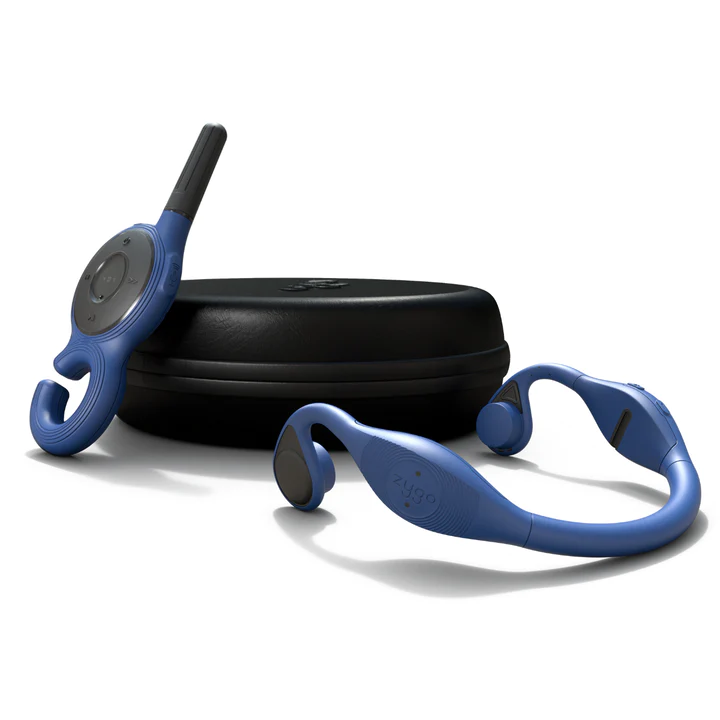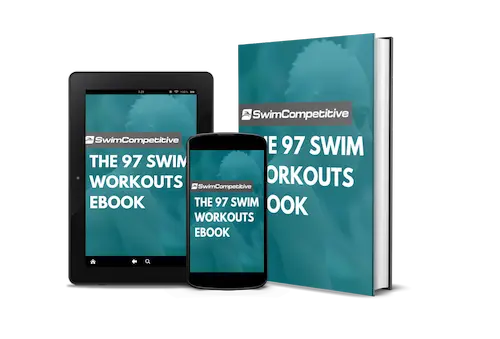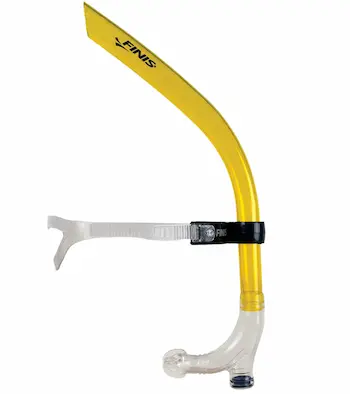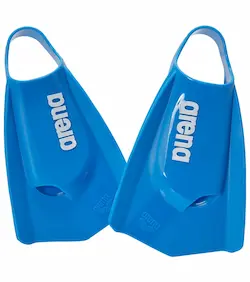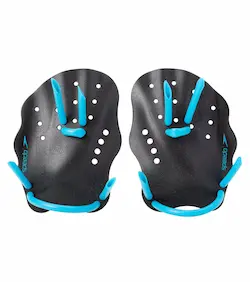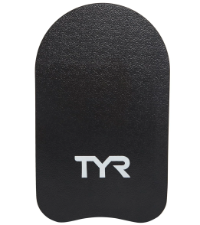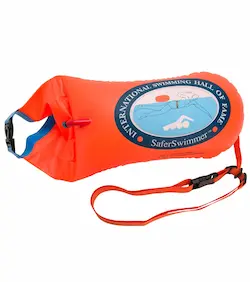After swimming wickedly skew and veering off track a few times, I finally reach the first buoy. I glance up to see how far I’ve still got to swim.
I’m shocked by the distance.
Even as an experienced competitive swimmer, it looks quite daunting. That’s despite regularly covering multiple miles in a single swim workout.
In my defense, I rarely swim open water (and kudos to those of you who do). If my mind wasn’t preoccupied with the giant crocodile coming from below to snatch me up, I was veering off track (only to find my teammates laughing at me at the finish line for swimming extra distance), or I was getting battered with waves.
That said, for many swimmers, the mile is an important milestone (yes, that’s a pun). So whether you’re just getting started or have been swimming for a while and want to see how you stack up, I’ll cover everything you want (and need) to know in this article.
I’ll discuss key topics like:
- The average mile swim time based on real-world data (I analyzed 67 278 swims dating back to 2003).
- Factors that can influence the average mile swim time.
- What a good mile swim time is for you based on your swimming level.
- How to track and measure your progress.
- How to improve your mile swim time.
- Swimming workouts to train for the mile.
- As well as answering some common questions that you may have.
Quick Terminology Brief: How Many Laps Is a Mile in Swimming?
When it comes to sports with confusing (and sometimes contradictory slang), swimming is up there.
Swimming has two different distances that are both referred to as a mile.
The pool mile (1650 yards/ 1500 meters) and the open water mile (1760 yards / 1609 meters).
| Type of Mile | Distance | Laps in a 25-yard pool | Laps in a 25-meter pool | Laps in a 50-meter pool |
| Pool Mile | 1650 yards/ 1500 meters | 66 | 60 | 30 |
| Open Water Mile | 1760 yards/ 1609 meters | 70.4 | 64.4 | 32.2 |
This means that the pool mile is 110 yards (100 meters) short of an actual mile– and that somehow open water swimmers are the (more) sane of the bunch in this case.
But why is this?
The topic has a lengthy historical background. Without boring you with the details (which, if you are interested in learning about, you can read this article), it has to do with the fact that the 1500-meter swim is the longest Olympic swimming event.
And so the mile swim (in short-course yard pools) was adjusted to more accurately reflect that. Except, swimmers kept calling the distance a mile, despite the adjustment making it 110 yards short of an actual nautical mile.
Fun Fact: It might shock you to know that the current world record for the men’s and women’s pool mile swim stands at an expeditious 14 minutes and 31 seconds and 15 minutes 20 seconds, respectively, held by Sun Yang from China and Kate Ledecky from the United States.
Looking at the Data: the Average Mile Swim Time by Age and Gender
For this article, I am using an actual mile distance (1760 yards/ 1609 meters).
An Explanation of My Data Analysis
I analyzed the data from 67 278 open water mile swims completed over the past two decades, dating back to 2003.
The data was taken from the official results database of the Midmar Mile, which is publicly available online.
The Midmar Mile, which takes place annually in Pietermaritzburg, South Africa, is considered the world’s largest open-water race, attracting thousands of swimmers from all over the globe every year– everything from recreational athletes to Olympic medalists.
I’ve also had the opportunity to swim the event, except instead of doing 1 mile like a sane person, I did eight along with a couple of teammates– and although my results aren’t anything spectacular, I thoroughly enjoyed the experience.
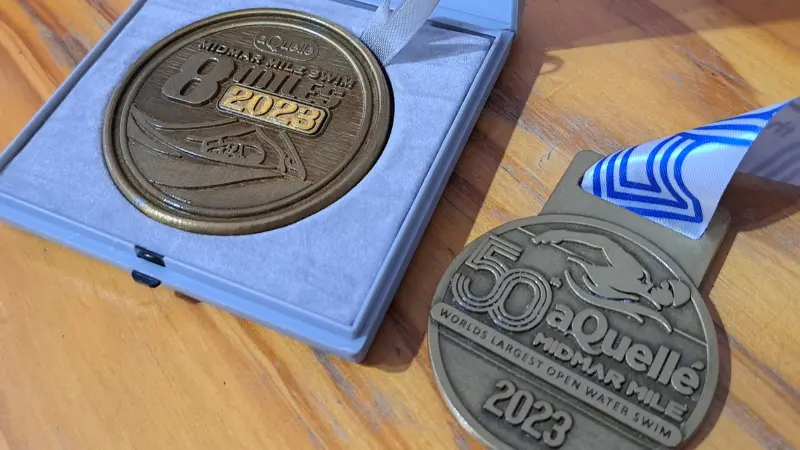
For simplicity (and keeping this article a reasonable length), I will only share the results of my findings. I spent hours manually plugging the data, creating formulas, and analyzing the results in a Google sheet. If I had to explain it all, it would take too long.
I also had to omit data in some cases where results were not reflected accurately or only partially available. That said, when I say I analyzed 67 278 swims, I mean it.
The data I’m about to share was calculated from the combination of these swims. Had all data been available, I most likely would have been able to analyze more than 100 000 swims.
The Results: The Average Mile Swim Time- Data from 67 278 Swims
Let’s start with an overview of the averages across the board. After that, I will go into more detail based on factors like age, gender, and swimming ability.
Note that most of the mile is swam freestyle (front-crawl). There may be instances where swimmers switch strokes to break things up and give certain muscles a break.
Overview of the Data for the Average Mile Swim Time
On average, across all age groups and abilities, males completed the mile swim in 37 minutes and 5.09 seconds, while females completed it in 38 minutes and 13.66 seconds. The combined average for the mile swim, irrespective of gender, is 37 minutes and 39.38 seconds.
| Gender | Average Mile Swim Time | Sample Size of Data |
| Male | 37 minutes 5.09 seconds | 34 437 swims |
| Female | 38 minutes 13.66 seconds | 32 841 swims |
| Combined (Male and Female) | 37 minutes 39.38 seconds | 67 278 swims |
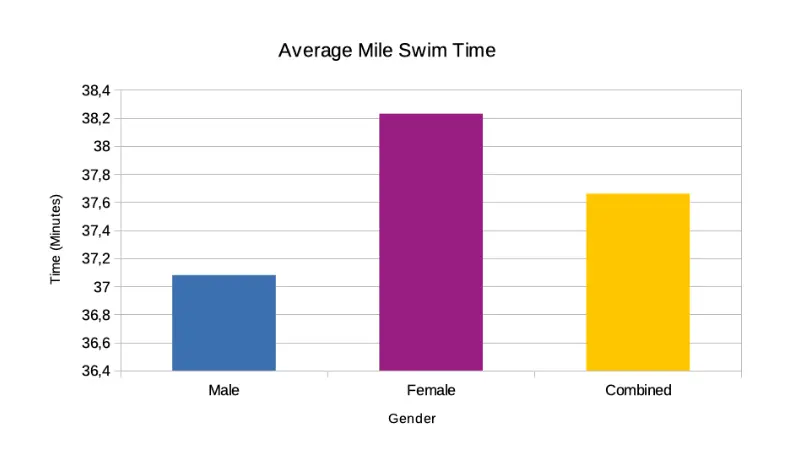
The Average Mile Swim Time Data in More Detail
Now that you have a broad overview of the average mile swim time, let’s break it down based on your age group.
This table represents the age-group data for males.
| Age Group | Average Mile Swim Time | Sample Size of Data |
| 13 and Under | 37 minutes 43.72 seconds | 4679 swims |
| 14 – 30 | 35 minutes 27.43 seconds | 15 581 swims |
| 31 – 40 | 37 minutes 49.37 seconds | 3663 swims |
| 41 – 50 | 38 minutes 25.92 seconds | 4206 swims |
| 51 – 60 | 39 minutes 22.66 seconds | 2277 swims |
| 61 – 70 | 42 minutes 1 second | 890 swims |
| 71 – 80 | 44 minutes 8.46 seconds | 127 swims |
| 81 + | 61 minutes 15.5 seconds | 4 swims |
This table represents the age-group data for females.
| Age Group | Average Mile Swim Time | Sample Size of Data |
| 13 and Under | 37 minutes 43.33 seconds | 4494 swims |
| 14 – 30 | 36 minutes 20.66 seconds | 14925 swims |
| 31 – 40 | 39 minutes 31.08 seconds | 2804 swims |
| 41 – 50 | 40 minutes 22.02 seconds | 2920 swims |
| 51 – 60 | 41 minutes 41.38 seconds | 1439 swims |
| 61 – 70 | 43 minutes 32.12 seconds | 424 swims |
| 71 – 80 | 46 minutes 15.74 seconds | 52 swims |
| 81 + | 47 minutes 32 seconds | 2 swims |
This table represents the combined age-group data.
| Age Group | Average Mile Swim Time | Sample Size of Data |
| 13 and Under | 37 minutes 43.53 seconds | 9173 swims |
| 14 – 30 | 35 minutes 54 seconds | 30 506 swims |
| 31 – 40 | 38 minutes 40.23 seconds | 6467 swims |
| 41 – 50 | 39 minutes 23.97 seconds | 7126 swims |
| 51 – 60 | 40 minutes 32.02 seconds | 3716 swims |
| 61 – 70 | 42 minutes 46.56 seconds | 1314 swims |
| 71 – 80 | 45 minutes 12.1 seconds | 179 swims |
| 81 + | 54 minutes 23.75 seconds | 6 swims |
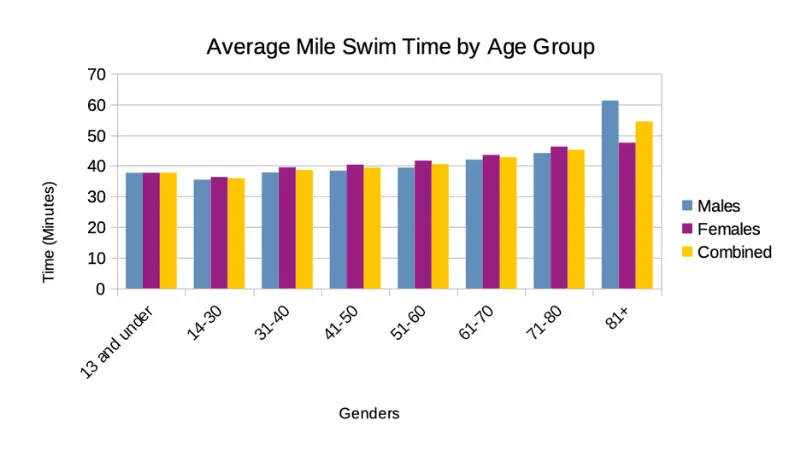
Overview of the Data for the Average Fastest Mile Swim Times
As I went through the data, I noticed it also included times for the fastest swims in each category. Since I was already analyzing the data, I decided to sort through this.
For most swimmers, this will be for interest’s sake. These times are really fast and will take years of training to achieve.
| Gender | Average Fastest Mile Swim Time (Open Water) | Sample Size |
| Male | 19 minutes 6.28 seconds | 12 |
| Female | 21 minutes 45.53 seconds | 12 |
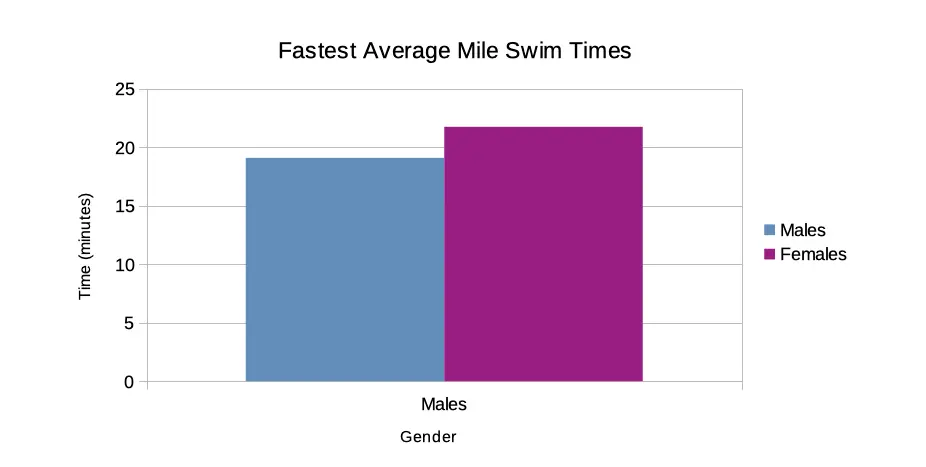
Factors That Influence the Average Mile Swim Time: an In-Depth Analysis of the Data
In this section, I cover some factors that will likely affect your average mile swim time.
Gender Affects Swimming Performance
On average, across all age groups, males were 1 minute and 8.57 seconds faster than females across the mile swim. Or from a percentage standpoint, 3.03% faster.
This isn’t a lot and likely has to do with the fact that swimming isn’t purely reliant on raw strength and power but more so on swimming technique and ability.
Even at extreme ends of the spectrum, the difference isn’t that large. For example, the difference between the world records for the pool mile swim is 5.47% between males and females. For the fastest average mile swim time, the difference is slightly larger at 12.98%.
Still, this difference isn’t as significant as you’d expect, with some studies reporting that the dynamic strength of females may vary from as low as 36% of that of males to as high as 74% of that of males.
Even at the high end, that’s a 26% difference– 13.02% Larger than the biggest difference between the average fastest mile swim time.
Another study published by Princeton University found an average strength difference ranging between 21.48-29.33% on the low-end and 30.97-39.44% on the high-end between males and females across the three powerlifting movement world records, namely the bench press, squat, and deadlift.
As this study published in the Journal of Functional Morphology and Kinesiology points out, these differences are likely related to gender differences in muscle morphology and lean body mass distribution between males and females. (Which can be heavily linked to natural hormones like testosterone).
Based on this empirical evidence, we can conclude that although biological differences in strength between males and females do indeed affect how fast they swim, it isn’t as prominent as in sports that are mostly strength-based, such as powerlifting, for example– at least not in long-distance events like the mile swim.
Age Affects Swimming Performance
Since we’ve already gone over gender differences in swimming performance, I will only be using the combined data to analyze the effects of age and how it can influence your mile swim time.
Across all age groups, the 14 to 30-year-old age category was the fastest on average.
The table below points out the average difference from both a time and percentage perspective compared to the 14 to 30-year-old age category.
| Age Group | Minute and Second Difference in Average Time Compared to the 14-30 Age Group | Percentage Difference in Average Time Compared to the 14-30 Age Group |
| 13 and under | 1 minute 49.53 seconds | 5.14% |
| 31 – 40 | 2 minutes 46.23 seconds | 7.72% |
| 41 – 50 | 3 minutes 29.97 seconds | 10.57% |
| 51 – 60 | 4 minutes 38.02 seconds | 12.67% |
| 61 – 70 | 6 minutes 52.56 seconds | 21.03% |
| 71 – 80 | 9 minutes 18.1 seconds | 24.25% |
| 81 + | 18 minutes 29.75 seconds | 46.21% |
Various reasons contribute to these differences. In the younger age category, the body has likely yet to develop fully, and swimmers have had fewer years of training, resulting in slower times.
For the older age categories, it’s likely a combination of a decline in the physical performance of the body as it ages and a reduction in overall physical activity and training compared to younger age groups.
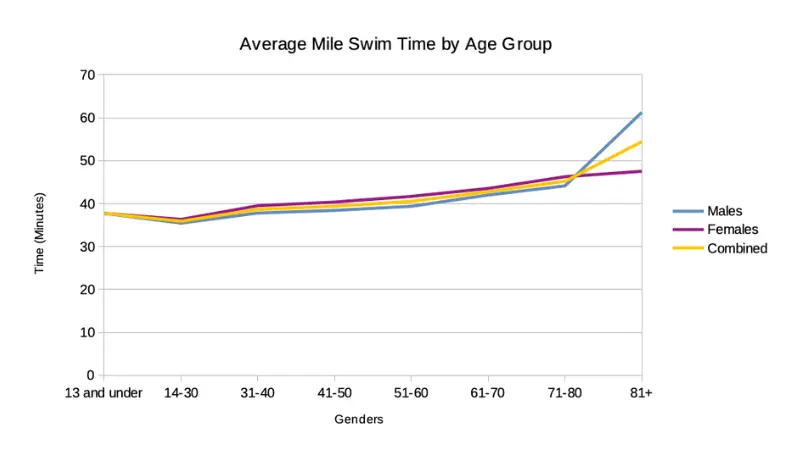
Your Swimming Level Is a Determining Factor
As our gender case study pointed out so nicely earlier, swimming has a lot to do with your technique and efficiency in the water.
In this case, I am encompassing a few things under the bracket of swimming level, such as:
- Your fitness level
- Your swimming technique and efficiency
- Your level of experience, for example, in swimming open water or swimming in certain swim events such as a mile.
All these things are essential and will contribute to your swimming level. Suppose you have low proficiency in these areas– in that case, you will likely be categorized as a beginner. In contrast, if you have a lot of proficiency, you are an advanced swimmer.
Beginners will have a slower average mile swim time compared to advanced swimmers.
Pool Vs. Open Water
Another important distinction is whether you are swimming your mile in open water or a pool.
Granted that we use the same distance of 1760 yards/ 1609 meters in both cases, a pool mile will be much faster than swimming in open water.
This has to do with things like:
- Visibility: In open water, it’s easy to go off track and swim extra distance adding to your time. This is often common for beginner open-water swimmers who don’t have proper orientation.
- Waves: Depending on environmental conditions like wind, there may be waves when you swim in open water, which can both slow you down, steer you off track, and increase the difficulty of your swim.
- No push-offs: Unlike in the pool, where you can push off the wall every 25 yards/meters or every 50 meters in the case of an Olympic pool, there are no walls when swimming in open water. This means no “free” speed and no underwaters, which can help you to swim significantly faster throughout a race.
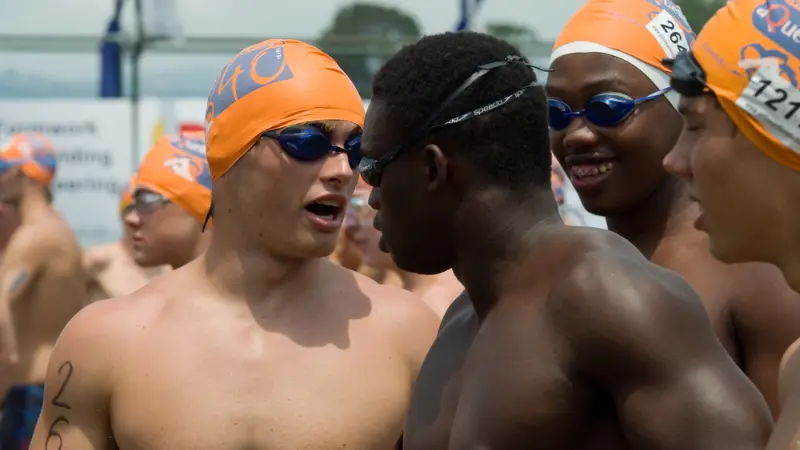
What Is a Good Mile Swim Time for You? Breaking It Down by Swimming Level
On average, it should take beginners anywhere from 45 to 60 minutes to swim a mile, while intermediate swimmers will be able to swim a mile in roughly 30 to 35 minutes and advanced swimmers in 25 minutes or less.
| Swimmer Level | Mile Swim Time |
| Beginner | 45 – 60 minutes |
| Intermediate | 30 – 35 minutes |
| Advanced | 25 minutes or less |
These numbers are just rough guidelines, though. There are other factors that will also come into play and may affect your results–things like whether you are swimming in open water or a pool, your age, and your gender.
That said, across all these factors (open water, age, gender), from my many years of swimming experience, I think these numbers are reasonable, irrespectively.
Try to swim a mile for a time during your next training session or race and see how close you can get.
Remember to stay patient with yourself and your training; you will get better as your technique improves and you become fitter and more experienced in the water.
Measuring Improvement: How to Track Your Mile Swim Time
Okay, now that you know what the averages are and what to aim for based on your swimming level, you need a way to find out where you lie on that spectrum.
Luckily, swimming technology has come a long way over the past few years, and there are some cool swim gadgets that can help you track this.
Smartwatches for Swimming: the Garmin Swim 2 or Apple Watch Series 8
When it comes to smartwatches for swimming, the Garmin Swim 2 or Apple Watch Series are always my go-to. These offer the most in terms of their swim tracking features and accuracy.
For those on a budget, I recommend the Garmin Swim 2. It has all the necessary swimming features and GPS tracking.
That said, if you have a couple of extra bucks you don’t mind spending, the Apple Watch Series 8 would be my preferred choice.
If you are an open-water swimmer, the smartwatch option should be your first pick for swim tracking since the built-in GPS feature allows for the most accuracy.
Smart Swim Goggles: the FINIS Smart Goggles
My favorite swim tracker is the FINIS Smart Goggles. These goggles feature a heads-up display allowing me to see my time, splits, and distance while swimming.
I like them because, unlike a smartwatch, they aren’t in the way of my stroke by adding weight to my wrist.
That said, when it comes to open-water swimming, the FINIS Smart Goggles aren’t my first pick.
The FINIS Smart Goggle is the most innovative smart swimming goggle available.
Directly display and track your laps, splits, set time, rest time, stroke rate, and more in your goggles with the non-intrusive heads-up display while swimming.
Bonus: ZYGO Swimming Headphones
While the ZYGO swimming headphones don’t currently support swim tracking (they will at some point in the future), they are a great way to spice up your workouts.
Unlike traditional mp3 swim headphones, these allow you to stream music or podcasts directly from your phone via Bluetooth. The Bluetooth signal is then converted to another frequency, enabling the headphones to work underwater.
The ZYGOs also come with an app that provides guided swim workouts if that’s something you’re interested in.
Stream music, podcasts, audiobooks, and more from any device directly to the innovative Zygo swimming headphones. Download the Zygo App for guided audio workouts, music, and more. The transmitter also enables live coaching.
Do You Want to Make Every Lap Count?
Stop wasting your time in the pool feeling lost and doing directionless swim workouts, and start training effectively! Our ebook contains 97 structured and goal-orientated swim workouts to help you become a better, faster, and fitter swimmer. Whether you’re a complete beginner or a seasoned pro, there are a multitude of workouts for every type of swimmer.
How to Swim a Mile Faster: 8 Practical Tips You Can Start Applying Immediately
Here are some tips for improving your mile swim time.
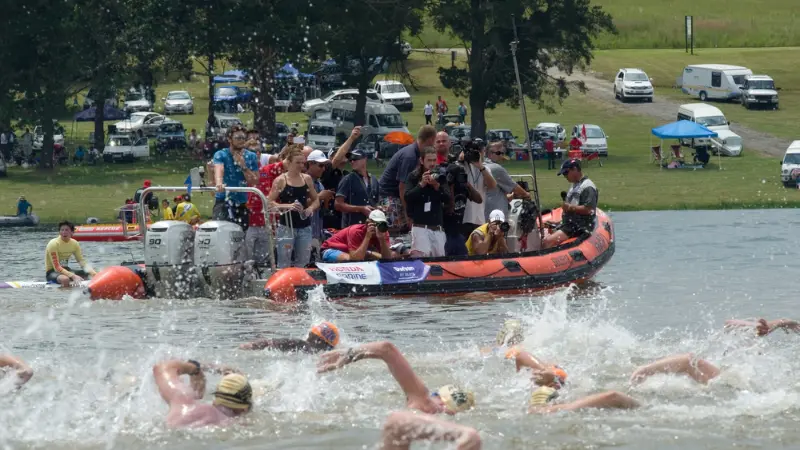
Goal Setting, Benchmark Test, and Self-Reflection
Before doing anything, you need to determine what your goal is. You aren’t likely to stick to your training without a clear why. In short, you are setting yourself up for failure.
Your goal may be to have the ability to swim a mile without stopping or to swim it in under an hour or under 30 minutes.
Once you know your goal, go and swim a mile and time yourself to see how long it takes. If you can’t swim a mile, see how far you can go without stopping and work from there.
The next step is to set up a swim log. By logging your workouts and reflecting on them, you can quickly identify areas that need work and find what’s working well. By doing this, you will be able to speed up your swimming progress significantly.
Train Consistently
Once you know your goal and where you stand in relation to it, you need to start training.
The most crucial aspect, however, is to train consistently. Even if the quality of your workouts is low in the beginning, it doesn’t matter. The most important aspect is establishing the habit and consistency of showing up and swimming when you need to.
“I think to be great, you have to be consistent. Come to practice every day with the mentality that you’re going to improve. If you do that throughout a long season, by the end of the season, you’re going to have come pretty far.”
– Ryan Murphy (6x Olympic Medalist)
How much you swim will depend on your goals. If three times a week is adequate for you, that’s fine. But make sure to swim three times a week– every week.
Swimming more will result in faster progress but will also require more discipline. Similarly, if you have a big goal, say swimming a mile in under 25 minutes, you’ll likely have to swim more as well.
That said, if you’re new to swimming, don’t start by trying to train six times a week since this can increase your likelihood of burnout, injury, and giving up. Instead, start slow by training a few times a week and build up from there.
Pro Tip: Train at the same time every day. Make sure to schedule it on a calendar or day planner. This will take away the need for willpower to get to the pool. If it’s on your schedule, then that’s simply what you do at that time of the day. It will also make organizing your life easier since you can schedule other priorities like school or work to fit with your training.
Improve Your Swimming Technique and Use Drills
Being a good swimmer is a combination of things– speed, power, conditioning, strategy, and skills– but perhaps the most important of them all (after consistency) is your technique, especially when it comes to long-distance swimming.
Make sure to have a dedicated portion of your workout directed towards technique work and swimming drills. I can not overstate the importance thereof.
Yes, it’s essential to be fit and strong, but without proper swimming technique, you aren’t going to get very far. If your technique is bad, you’ll experience a lot of water drag and expend much more energy than needed.
The good news is you don’t have to dedicate your entire workout to technique. (Although there are times when you can and probably should).
By allocating a small portion at the start of your workout to technique and drills, you can spend the rest of the workout working on other things like speed and conditioning– but (here’s the catch) keeping the specific technique point you worked on in mind. Thus compounding the effect and helping you to improve your swimming rapidly.
For an in-depth breakdown of this, consider reading my article on how to improve your long-distance swimming technique.
Improve Endurance and Aerobic Conditioning
Once you’ve got your swimming technique down and you’re in the pool consistently, it’s time to start working on some training specific to the mile swim.
The first aspect is to improve your endurance and aerobic conditioning.
This can be done by breaking the mile up into sets of various distances.
For beginners, the purpose would be to work up to being able to swim a mile in one go, but for more experienced swimmers, this can be utilized to work on speed or technical points.
Here are some example sets for improving your endurance.
- Set 1: 16x100s, 20 seconds rest between each 100. Focus on maintaining good technique.
- Set 2: 8x200s, 10 seconds rest between each 100. Focus on maintaining good technique.
- Set 3: 4x400s on an interval, e.g., on 6:00.
- Set 4: 2x800s, 30 seconds rest, or an interval of choice (make it challenging).
You can also add to these sets by using equipment or focusing on other aspects of your swimming.
For example, snorkels are a great way to improve your conditioning and breathing efficiency further. If you are comfortable swimming 8x200s, try adding a snorkel to make it more challenging, work on your technique, or improve your breathing.
Swim on Intervals and Add Sprint and Power Work
You may have noticed that I used some intervals in the example sets in the previous section.
Intervals are a great way to push yourself to swim faster. They force you to cover a certain distance within a specific time.
Intervals can be easier or more challenging, depending on your goal. For example, if you are working on speed, you use a faster interval, but if you are working on aerobic conditioning, you can use a slower interval.
The FINIS Smart Goggles will help make interval swimming effortless by showing your splits, distance, and times in real-time while you swim.
The FINIS Smart Goggle is the most innovative smart swimming goggle available.
Directly display and track your laps, splits, set time, rest time, stroke rate, and more in your goggles with the non-intrusive heads-up display while swimming.
Usually, intervals aren’t a beginner technique and should only be implemented once you’ve built a decent base of swimming endurance and technique.
I also recommend incorporating some sprint and power swimming to work on your raw speed.
Here are some example sets:
- Set 1: 4x100s on 90% effort on 2:00.
- Set 2: 4x100s at 90%, 30 seconds rest in between.
Using equipment like fins and paddles is a great way to develop power in your stroke. They also work well in combination with sprinting since they help you swim faster.
Here are some more example sets:
- Set 1: 4x100s, 75m overspeed with fins and paddles, 25m easy swim.
- Set 2: 4x100s with paddles focusing on a strong pull and correct hand entry, 10 seconds rest.
- Set 3: 4x200s with fins, focusing on a strong kick on 3:30.
- Set 4: 4x400s descend from easy to fast by 400 with fins, paddles, and a snorkel on an interval.
If you are looking for some gear recommendations, my favorite swimming fins are the Arena Powerfin Pros:
Quick summary: The Arena Powerfin Pro is a premium swimming fin made from durable 100% silicone material. Its short inclined blade and hydrodynamic slits enable high-frequency kicking, improving leg strength and power.
Additional cuts on the bottom increase kick power. The open-heel design maximizes ankle flexibility, providing a comfortable fit.
And for paddles, I recommend the Speedo Nemesis Contours:
Quick summary: The Speedo Nemesis Contour Swim Paddle is suitable for all swimmers and has a unique contoured design for an enhanced feel for the water and correct hand entry.
The scalloped edges increase water resistance and facilitate natural pulling for technique and power. Additional features include adjustable straps, holes for water flow, and three size options.
Build a Strong Kick
Many recommend using a 2-beat kick for distance swimming to conserve energy. While this is a useful strategy for covering long distances efficiently, it’s not the best strategy when it comes to swimming as fast as possible.
While a mile is a decent distance to cover in the water, it also isn’t extreme. You’ll likely benefit speed-wise from using a higher tempo kick such as a 4-beat or a 6-beat kick.
But what exactly is a 2-beat, 4-beat, and 6-beat kick?
A 2 beat kick is when you kick once during every arm stroke (twice for one arm cycle, which is two strokes in freestyle). A 4-beat kick is when you kick twice during every arm stroke, and a 6-beat kick is (yes, you guessed it) when you kick three times during every arm stroke.
Yes, this will be hard and tire you out, but you’ll also swim much faster.
Include some kicking sets in your workouts to work specifically on your kick. A kickboard can be an excellent addition to use here. That said, also make sure to include some body position kicking.
Quick Summary: The TYR Kickboard is the perfect kickboard featuring simplicity, performance, and durability for all swimmers. The kickboard has a traditional design and is constructed from highly-durable 2-inch close-cell EVA foam. Additional chlorine resistance ensures durability.
Add Dryland Training to Your Routine
Once you’ve got your swimming base down, it’s time to supercharge it with dryland training.
Dryland training encompasses any training done outside of the water.
To best spend this time, I recommend doing strength and power work in the gym. Building up strong core muscles is also very important for swimming.
You might be thinking– but we are training for distance swimming; shouldn’t we instead be focused on improving our endurance?
Simply put. No.
Yes, there are times when it can be beneficial to work on conditioning outside of the water, but for most swimmers, building strength will yield the most significant returns.
You are already training your endurance and conditioning in the pool– instead, spend your training outside of the water focusing on strength.
By improving your strength first, you are able to generate more power, swim faster for longer, maintain better stroke efficiency, and prevent injuries.
For exercises, consider reading my article on weight training for distance swimmers.
Here are some additional dryland articles that you may want to consider checking out:
- Weight training for swimmers.
- Strength training for swimmers.
- Upper body exercises for swimmers.
- Leg exercises for swimmers.
- Arm exercises for swimmers.
- Strength exercises for swimmers.
Train in Open Water
One of the things I struggled with most when doing my 8-mile swim was orientation. Since I’m an experienced swimmer, the swimming portion wasn’t too challenging (apart from getting some bad weather on the last mile), but staying on track was a pain– and something that slowed me down a lot.
Therefore, if you plan on swimming your mile in open water, I recommend getting at least a dozen or so training sessions in these conditions. This will teach you how to maintain orientation and stay on track when swimming.
By veering off track, you are swimming extra distance and potentially adding a lot of time to your mile swim.
For your safety, I recommend using an open-water swim buoy when training in open water. This makes you visible to boats and jet skis that might be on the water and serves as a floatation device to hold onto if you need a break or experience a cramp while swimming. It can also be an identifier for lifeguards to find you easily, should it be required.
Swimming Workouts to Train to Swim a Mile: Structure and Examples
Here is a basic swimming workout outline and some example swim workouts.
Basic Outline for an Efficient Swim Workout
- Warmup: Easy swimming to get the blood flowing (200-800 meters/ yards, but it can be more depending on your needs).
- Pre-set (optional): An excellent place to include drills, activation, technique, or breathwork. (300-600 meters/ yards).
- Mainset: The bulk of your swim workout. It can be broken down into rounds and subsets, or you can have more than one mainset. The length will depend on your goals.
- Post-set (optional): Another opportunity for drills, technique, breathwork, or anything specific you want to train.
- Cooldown: Easy swimming allowing the body to reset and enter a state of recovery. The distance depends on the intensity of your workout. A more strenuous workout requires a longer cooldown than an easier workout. (200-800 meters/ yards, but it can be more depending on your needs).
Related: Wondering how many laps you should do when swimming? Read my article on how many laps is a good swim workout.
Example Mile Swim Workout 1 (Beginners)
- Warmup: 200 choice swim.
- Pre-set: 8x25s choice drills, 5 seconds rest.
- Main-set: 10x100s with fins, 15 seconds rest.
- Cooldown: 200 backstroke swim.
- Total: 1600 yards/ meters.
- Duration: 40-45 minutes.
- Focus: Aerobic fitness and technique.
If this is too much for you to start with, reduce the main set by 50% or break it up into 50s and work from there.
Example Mile Swim Workout 2 (Intermediate)
- Warmup: 400 choice swim.
- Pre-set: 8x50s hypoxic swimming (breathe every 3, 5, 7, and 9 arm strokes by 50, repeat two times), 20 seconds rest.
- Main-set: 6x200s on 4:00 with a snorkel.
- Post-set: 4x50s kicking with a kickboard and fins at 90% effort, 30 seconds rest.
- Cooldown: 300 backstroke swim.
- Total: 2500 yards/ meters.
- Duration: 1 hour – 1 hour and 10 minutes.
- Focus: Aerobic fitness and breathing efficiency.
Example Mile Swim Workout 3 (Advanced)
- Warmup: 500 choice swim.
- Pre-set: 12x50s kicking with a kickboard, sprint kick last 25m of each 50 on 1:00.
- Main-set 1: 4x400s with fins and paddles, descend from easy to fast at 6:00.
- Main-set 2: 2x800s with a snorkel focus on one stroke technique point for each 800.
- Cooldown: 400 backstroke swim.
- Total: 4700 yards/ meters.
- Duration: 1 hour 45 minutes – 2 hours.
- Focus: Aerobic speed and conditioning combined with kicking and technique work.
Is It Good to Swim a Mile a Day?
Swimming a mile a day is a good target to aim for. Since swimming is low-impact, this is a very manageable distance to swim and will benefit your health.
Beginners may struggle to swim this distance daily since they still need to build up conditioning and technique. That said, for intermediate and advanced swimmers, a mile a day will be manageable and shouldn’t take long.
Keep in mind intermediate and advanced swimmers may need to swim more distance daily to keep progressing their swimming.
Will I Lose Weight Swimming 1 Mile a Day?
Losing weight is not just about how far you swim but more about your calorie expenditure. That said, if your diet is right, a mile a day can help you burn some extra calories, which will aid you to lose weight.
Simply put- to lose weight, you must burn more calories than you consume.
Most people will require a dietary adjustment to achieve this goal. This means eating slightly less each day or eating healthier foods that aren’t as calorie-dense. This, combined with exercise, will help you to lose weight effectively.
If you’d like to learn how to make the necessary dietary adjustments to lose weight, I recommend reading my article on creating a meal plan for swimmers.
Apart from losing weight, I still recommend adding some swimming (or any exercise), as this will significantly benefit your overall health and well-being.
Is It Hard to Swim a Mile?
For most swimmers, swimming a mile shouldn’t be too challenging.
However, beginners may find swimming a mile challenging since they likely still lack the necessary technique and conditioning to swim efficiently.
That said, the level of difficulty will depend on various factors, such as:
- Whether you are swimming the entire mile in one go.
- How fast are you swimming the mile?
- Is it in open water or a pool?
- Are you using any equipment to aid you, like fins?
- Are you recovered from your previous workout?
For most advanced swimmers, the mile will be more in the realm of tedious rather than challenging. But as mentioned, beginners and even intermediate swimmers may find it difficult.
Your Mile Swim Time Depends on Various Factors!
To some, swimming a mile can be a considerable challenge. To others, it is the easiest thing in the world.
It all depends on your swimming level, technique, and general conditioning– as well as a few factors that are out of your control, like age and gender.
At the end of the day, it should come down to challenging yourself and swimming the best time you can. (Or just finishing the mile in one go if that’s your goal).
Continually strive to work hard in training and to stay consistent. Before you know it, you will have an impressive mile swim time that you can brag about.
